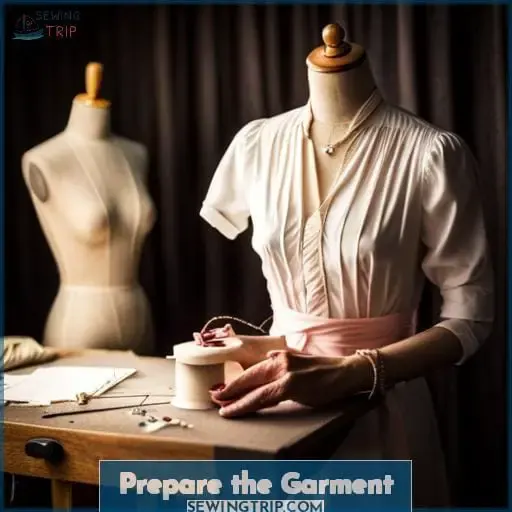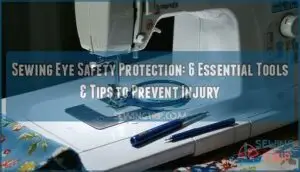This site is supported by our readers. We may earn a commission, at no cost to you, if you purchase through links.
 The sleek freedom of a handcrafted garment caresses your skin like an exhale of self-expression. Tracing treasured threads to birth beloved replicas gratifies the soul’s yearning for more.
The sleek freedom of a handcrafted garment caresses your skin like an exhale of self-expression. Tracing treasured threads to birth beloved replicas gratifies the soul’s yearning for more.
Let’s trace any top you love without dismantling it, copying your truth into a pattern for boundless iterations.
Armed with tracing paper, tape, and a ruler, you’ll recreate the naked lines of a cherished garment. Choose a well-fitting template in a fabric you can mimic, then prepare and tape it strategically.
Trace each piece gently, preserving all its curves and secrets. Add seam allowances, mark alterations, then cut and sew a test version.
Adjust until your pattern yields the living likeness you envisioned.
Table Of Contents
Key Takeaways
- Trace taped sections of the garment onto transfer paper to create a custom pattern.
- Prepare the garment by laundering and ensuring it fits well before taping.
- Add seam allowances to the traced pattern pieces before cutting the fabric.
- First, sew a test garment and make adjustments before copying embellishments.
Get the Right Tools
When copying your favorite top, you’ll need a few basic tools to get started. To make a pattern from an existing garment, be sure to have on hand tracing paper, painter’s tape, and a flexible ruler for accurately tracing curves and seam lines.
Tracing Paper
You’ll want to have some nice, sturdy tracing paper handy so you can smoothly transfer the taped pattern pieces from your favorite top onto it. During this step, mindful placement on the tracing paper allows you to customize the final pattern.
Embrace small imperfections that give your handmade garment an intimate feel, while mimicking a cherished design.
Tape
Step one is to get helpful tape to start tracing the pattern, ironically only for it to be ripped off later anyways! Overlap narrow tape along curved lines where the pattern may distort when removed; lay longer strips along straight seams while tracing armholes and necklines critical for fit.
Preserve original darts and pleats with tape that stabilizes shapes for transfer. Replicate each seam and curve perfectly for precision sewing your own beloved tops.
Ruler
Use a flexible ruler to accurately duplicate any curves. When copying a favorite garment, a flexible ruler allows you to trace curved seams precisely. Gently bend the ruler to follow dips and curves while tracing; don’t force rigid edges.
For sleeves, trace the entire armscye from shoulder seam to hem. Check alignments and make small adjustments to your pattern if needed.
Choose the Garment to Copy
When choosing the garment to copy, start by selecting a perfectly fitting favorite that you want to recreate. Carefully examine the construction details like curved seams or pockets, and choose a similar fabric type to the original for the best duplicate results.
Choose Well-Fitting Garment
Make sure the original t-shirt hugs your curves just right before tracing its silhouette, my friend. Examine it closely for the perfect fit in the shoulders, bust, waist, and hips. Focus on a fabric selection similar in weight and drape to the vintage find.
Make notes on the pattern pieces for future fitting adjustments. Customize it through patternmaking techniques for sewing satisfaction from this intimate process of garment examination.
– Examine Construction Details
Study the original top’s style lines, seam placement, and finishing to understand the construction. Analyze the fabric and notions while considering pattern customization options. Examine details like darts, yokes, pleats and pockets for replication.
Note any special alterations needed through thorough construction analysis before selecting your fabric.
– Select Similar Fabric Type
Match the fabric’s hand so your recreated top hangs and drapes just like your treasured original. Fabric selection dictates fit, comfort, drape, and feel. Choose a material with similar weight, weave, and stretch.
Hand sample fabrics for comparison before copying from your vintage find. Make pattern adjustments for different types to perfect the custom fit. Then sew using these garment copying methods and patternmaking principles. Celebrate your creative freedom in this fabric world.
Prepare the Garment
Examine your top thoroughly before taping to identify areas that need tracing versus taping. Check the fabric type, weight, stretch, and drape to select the best matching fabric for your copy. Make sure the top is freshly laundered, pressed, and fits the way you want before beginning.
Make any needed alterations to the original first, like adjusting shoulder seams or taking in the sides.
Prepare by gathering your tracing tools and tape before starting. Have an array of tape widths ready for curved seams. Place scrap paper inside front and back before taping to keep the garment smooth.
Proceed slowly and methodically when taping, pressing the tape down firmly but gently. Be extra careful when removing the tape to preserve the integrity of the pattern pieces.
With patience and precision, you’ll have an accurate pattern to recreate your cherished top.
Tape the Pieces
Lay strips of tape along the seam lines to create a temporary pattern. Apply narrow blue painter’s tape, following the contours of the original garment’s construction. Use shorter strips around curves, longer pieces for straight seams. Overlap edges slightly for easy removal.
Note subtle details like darts or zipper placement with quick sketches on the tape.
Examine how the pieces fit together, visualizing the puzzle of pattern shapes. Tape curved areas in small segments to capture the silhouette. Work slowly and methodically to get an accurate imprint. Check for distortion, gently smoothing and pressing as you go.
Honor the garment’s character, appreciating its spirit of freedom. With care and intuition, gently free the pieces from their taped cocoon, a liberation yielding the custom pattern within.
Trace Each Piece
Trace each taped section onto the transfer paper, keeping the tape strips in place as you go. Move slowly and deliberately to capture every curve and detail from the original garment with pattern accuracy.
Keep the tape flat and wrinkle-free as you trace, gently smoothing any sections that lift. Consider adding customized details like extended shirt tails or changing the neckline during this tracing step.
Once all pieces are traced, carefully remove the tape strips and cut out your pattern, adding seam allowances. When tracing off an existing garment, patience leads to precision. With an accurately copied pattern, you can recreate your favorite tee exactly as you love it, in the perfect fabric for you.
Test sew and make fit adjustments before cutting your final cloth. Celebrate handmade clothing and the freedom of fashion when you sew your own stunning t-shirt from a hand-traced pattern.
Create the Pattern
Listen up, you’ll want to add seam allowances and mark any alterations on your newly drafted pattern pieces. This ensures the pieces will fit together properly and creates a record of custom sizing for next time.
Add Seam Allowances
To accurately construct garments, add 5/8 inch seam allowances to each traced pattern piece. Use a tracing wheel and ruler to precisely mark the allowances around the outlines. Mark notch points along the seam lines, transferring any original pattern markings.
Before cutting the fabric, check that adjoining seams fold perfectly. Making minor tweaks preserves the original fit. Now you can sew an exact replica or customize the pattern further with creative techniques.
These skills enable replicating cherished garments while expressing yourself through clever alterations.
Mark Alterations
After you’ve traced the pattern pieces, thoughtfully mark any necessary alterations for a perfect custom fit. Study the original garment and note where it could fit better. Mark those areas on the pattern for adjustment.
Add length to sleeves or sides. Take in excess fabric at the waist or other areas. Make small bust changes. Whatever fit modifications you need, alter the pattern now before cutting fabric. Thoughtfully translate the garment’s quirks into pattern adjustments. Your customizations ensure a flawless duplicate design with an ideal fit tailored just for you.
Cut Out the Pattern
After tracing your pattern pieces onto paper, it’s time to carefully cut them out.
- Use sharp scissors for clean cuts along the traced lines. Dull blades can lead to jagged edges.
- Add seam allowance to each piece. 1/2” is standard for most garments. Mark the sewing line and cutting line.
- Cut notches where marked to indicate dart points, pockets, etc. These help align pieces later.
- Cut on the fold for symmetrical pieces like front bodice and back. This eliminates extra seams.
- Label each pattern piece with its name, fabric cut number, and any alterations. This prevents mix-ups.
With your meticulously cut pattern pieces in hand, you’re ready for the next exciting step – seeing your design come to life in fabric! Thoughtful pattern preparation leads to a perfectly customized garment.
Sew a Test Garment
Try sewing a test garment before you cut into the real fabric. This helps you get the fit and details just right. Choose a fabric with a similar weight and drape to your final one so it gives an accurate read on how it’ll hang on ya.
Get creative and use an old bedsheet or some muslin so you can check the pattern sizing. Mark any alterations with a fabric pen directly on the test version. Play around with customizing the neckline or lengths based on how it fits your unique curves ‘n shape.
Experiment with different seam finishes, closures, even pockets. No need to go full-out, just focus on checking key areas like the shoulders, bust, waist and hips for a proper fit. Once you feel confident with the sample, go ahead ‘n cut that dream fabric knowing the end garment will fit like a glove and move with you just right.
Make Adjustments
You could mimic a draftsman tracing landmarks as you tailor the copied pattern to sew a more flattering fit.
- Take in or let out seams based on the fit of the test garment.
- Adjust darts at the bust and waist for shaping.
- Modify the sleeve cap for better arm movement.
- Taper or straighten the side seams for a smooth silhouette.
Test sewing the adjusted pattern and continue tweaking it until it fits just right. Make notes on the pattern pieces for future use. Play with creative patternmaking techniques to make it your own.
Frequently Asked Questions (FAQs)
Can I copy details like pockets or embellishments? The article focuses on the overall shape but additional details need to be considered.
You can copy pockets, embellishments, and other details. Carefully trace each element, noting placement, shape, and dimensions. Add them to your pattern pieces in the same positions. You may need to draft small pattern pieces for intricate details.
Take your time and don’t rush this step; precision here means accuracy in your finished garment.
Conclusion
And that’s how you can copy your favorite top without taking it apart. While tracing paper and tape may seem unconventional at first, they make copying a breeze – with a dose of irony since we often think of destructive measures like cutting or ripping when replicating clothes.
By taping, tracing, and transferring each cleverly taped piece to create your own custom pattern, you’ll sew an identical garment in your choice of fabric in no time.















